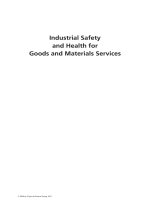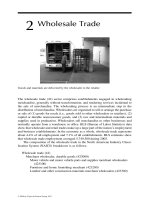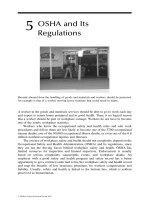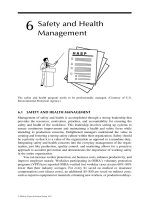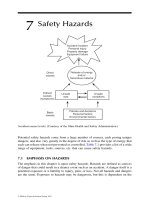Industrial Safety and Health for Goods and Materials Services - Chapter 23 pptx
Bạn đang xem bản rút gọn của tài liệu. Xem và tải ngay bản đầy đủ của tài liệu tại đây (221.15 KB, 16 trang )
23
Other Hazards
The retail, wholesale, and warehousing sectors are the sectors that handle, store, and
disperse the largest quantities of goods and materials in the United States. Since all
the potential hazards faced by these three sectors cannot be addressed in detail in one
book it may be necessary to use Industrial Safety and Health for Infrastructure
Services, Industrial Safety and Health for Administrative Services, and Industrial
Safety and Health for People-Oriente d Services to address other hazards. This
chapter provides summaries regarding some of the other common hazards that
confront workers in these sectors. Some of these hazards are also covered in some
detail in the other three books mentioned above.
Some of the hazards that were not covered extensively in this book are
as follows:
.
Compressed air
.
Lockout=tagout
.
Dockboards
.
Electrical
.
Fueling
.
Powered tool s
.
Scaffolds
.
Tire inflation
.
Workplace violence
Tire inflation and repair can be deadly. (Courtesy of Mine Safety and Health Administration.)
ß 2008 by Taylor & Francis Group, LLC.
23.1 COMPRESSORS AND COMPRESSED AIR (29 CFR 1910.242)
A compressor supplies compressed air. Great care must be taken to ensure such types
of equipment are operating safely. Safety devices for a compressed air system should
be checked frequently. Compressors should be equipped with pressure relief valves
and pressure gauges.
The air intakes must be installed and equipped so as to ensure that only clean
uncontaminated air enters the compressor. This is facilitated by the installation of air
filters on the compressor intake.
Before any repair work is done on the pressure system of a compressor, the
pressure is to be bled off and the system locked out. All compressors must be
operated and lubricated in accordance with the manufacturer’s recommendations.
Signs are to be posted to warn of the automatic starting featu re of compressors. The
belt drive system is to be totally enclosed to provide protection from any contact.
No worker should direct compressed air toward a person, and employees are
prohibited from using highly compressed air for cleaning purposes. If compressed air
is used for cleaning clothes, the pressure is to be reduced to less than 10 psi. When
using compressed air for cleaning, employees should wear protective chip guarding
eyewear and personal protective equipment.
Safety chains or other suitable locking devices are to be used at couplings of high
pressure hose lines where a connection failure would create a hazard. Before
compressed air is used to empty containers of liquid, the safe working pressure of
the container is to be checked.
When compressed air is used with abrasive blast cleaning equipment, the operat-
ing valve type must be held open manually. When compressed air is used to inflate auto
tires, a clip-on chuck and an inline regulator preset to 40 psi are required. Compressed
air should not be used to clean up or move combustible dust because such action could
cause the dust to be suspended in the air and cause a fire or explosion hazard.
23.2 CONTROL OF HAZARDOUS ENERGY SOURCES
(LOCKOUT=TAGOUT) (29 CFR 1910.147)
Lockout=tagout deals with the preventing of the release of energy from machines,
equipment, and electrical circuits which are perceived to be de-energized. The
Occupational Safety and Health Administration (OSHA) estimates compliance
with the lockout=tagout standard will prevent about 120 fatalities and approximately
28,000 serious and 32,000 minor injuries every year. About 39 million general
industry workers will be protected from accidents during maintenance and servicing
of equipment under this ruling.
The standard for the control of hazardous energy sources (lockout=tagout) covers
servicing and maintenance of machines and equipment in which the unexpected
energization or startup of the machines or equipment or release of stored energy
could cause injury to employees. The rule generally requires that energy sources for
equipment be turned off or disconnected and that the switch either be locked or
labeled with a warning tag. About 3 million workers actually servicing equipment
face the greatest risk. These include craft workers, machine operators, and laborers.
ß 2008 by Taylor & Francis Group, LLC.
OSHA’s data show that packaging and wrapping equipment, printing presses, and
conveyors account for a high proportion of the accidents associated with lock-
out=tagout failures.
Typical injuries include fractures, lacerations, contusions, amputations, and
puncture wounds with the average lost time for injuries running 24 days. Agriculture,
maritime, and construction employers are not covered under standard 29 CFR
1910.147. Also, the generation, transmission, and distribution of electric power by
utilities and work on electric conductors and equipment are excluded. The general
requirements for the ruling require employers to
.
Develop an energy control program.
.
Use locks when equipment can be locked out (Figure 23.1).
.
Ensure that new equipment or overhauled equipment can accommodate
locks.
.
Employ additional means to ensure safety, when tags rather than locks are
used by using an effective tagout program.
.
Identify and imp lement specific procedures (generally in writing) for the
control of hazardous energy including preparation for shutdown, shutdown,
FIGURE 23.1 Locking out a plug on a saw.
ß 2008 by Taylor & Francis Group, LLC.
equipment isolation, lockout=tagout application, release of stored energy,
and verificati on of isolation.
.
Institute procedures for release of lockout=tagout including machine inspec-
tion, notification and safe positioning of employees, and removal of the
lockout=tagout device.
.
Obtain standardized locks and tags which indicate the identity of the
employee using them and which are of suf ficient quality and durability to
ensure their effectiveness.
.
Require that each lockout=tagout device be removed by the employee who
applied the device.
.
Conduct inspections of energy control procedures at least once a year.
.
Train employees in the specific energy control procedures with training
reminders a s part of the annual inspections of the control procedures.
.
Adopt procedures to ensure safety when equipment must be tested during
servicing, when outside contractors are working at the site, when a multiple
lockout is needed for a crew servicing equipment, and when shifts or
personnel change.
Excluded from coverage are normal production operations including repetitive,
routine minor adjustments which would be covered under OSHA’s machine guard-
ing standards. Work on cord and plug connected electric equipment when it is
unplugged, and the employee working on the equipment has complete control of
the plug. Hot tap operations involving gas, steam, water, or petroleum products when
the employer shows that continuity of service is essential, shutdown is impractical,
and documented procedures are followed to provide proven effective protection for
employees.
In summary all machinery or equipment capable of movement is required to be
de-energized or disengaged and locked out during cleaning, servicing, adjusting, or
setting up operations, whenever required. Where the power disconnecting means for
equipment does not also disconnect the electrical control circuit, the appropriate
electrical enclosures must be identified. A means should be provided to assure the
control circuit can also be disconnected and locked out. The locking out of control
circuits in lieu of locking out main power disconnects must be prohibited. All
equipment control valve handles are to be provided with a means for locking out.
Lock-out procedures require that stored energy (mechanical, hydraulic, air, etc.) be
released or blocked before equipment is locked out for repairs. Appropriate employees
must be provided with individually keyed personal safety locks and are expected to
keep personal control of their keys while they use safety locks. Only the employee
exposed to the hazard should place or remove the safety lock. Employees must
check the safety of the lock out by attempting a startup after making sure no one is
exposed. Employees need to be instructed to always push the control circuit stop
button immediately after checking the safety of the lock out. A means is to be
provided to identify any or all employees who are working on locked-out equipment
by their locks or accompanying tags. A sufficient number of accident preventive
signs or tags and safety padlocks need to be provided for any reasonably foreseeable
repair emergency. When machine operations, configuration, or size requires the
ß 2008 by Taylor & Francis Group, LLC.
operator to leave his=her contr ol station to install tools or perfor m other operations ,
and that part of the machine could move if accide ntally activated, that element is
required to be separa ted, locked, or blocke d out. In the event that equipm ent or lines
cannot be shut down , locked out, and tagged , a safe job procedu re is to be estab lished
and rigidly followed.
23.3 DOCKBOARDS (29 CFR 1910.30)
Dockboards are to be strong enough to carry the load imp osed up on them (See
Figure 23.2). Portab le dockboar ds a re to be anchore d or equipped wi th device s that
will prevent their slipping . Handholds shoul d exist on dockboa rds which provide a
safe and effect ive means of handlin g. Railr oad cars shoul d be provided with a
mechanism that would prevent movem ent while dockboar ds a re being used.
23.4 ELECTRICAL (29 CFR 1910.303, .304, .305, .331, AND .333)
Electrici ty is accepted as a source of powe r without much though t to the hazards
encountered. So me empl oyees work with electrici ty direc tly, as is the case with
engineers, elect ricians, or p eople who do wiring , such as overhea d lines, cable
harnesses, or circuit assemblies. Others, such as office workers and salespeople,
work with it indirectly. Approximately 700 workers are electrocuted every year with
many wor kers suffe ring injuries such as burns, cuts, etc. (Figur e 23.3).
FIGURE 23.2 Example of dockboards or plates for loading a trailer at a dock.
ß 2008 by Taylor & Francis Group, LLC.
OSHA’s electrical standards address the government’s concern that electricity
has long been recognized as a serious workplace hazard, exposing employees to such
dangers as electric shock, electrocution, fires, and explosions. The objective of the
standards is to minimize such potential hazards by specifying design characteristics
of safety in use of electrical equipment and systems.
Electrical equipment must be free from recognized hazards that are likely to
cause death or serious physical harm to employees. Flexi ble cords and cables
(extension cords) should be protected from accidental damage. Unless specifically
permitted flexibl e cords and cables shoul d not be used as a substitute for the fixed
wiring of a structure, where attached to building surfaces, where concealed or where
they run through holes in walls, ceilings, or floors, or where they run through
doorways, windows, or similar openings. Flexible cords are to be connected to
devices and fittings so that strain relief is provided that wi ll prevent pull from
being directly transmitted to joints or terminal screws.
A grounding electrode conductor is to be used for a grounding system to connect
both the equipment grounding conductor and the grounded circuit conductor to the
grounding electrode. Both the equipment grounding conductor and the grounding
electrode conductor are to be connected to the ground circuit conduct or on the supply
side of the service disconnecting means or on the supply side of the system disconnect-
ing means or overcurrent devices if the system is separately deriv ed. For ungrounded
service-supplied systems, the equipment grounding conductor should be connected to
the grounding electrode conductor at the service equipment. The path to ground from
circuits, equipment, and enclosures should be permanent and continuous.
Electrical equipment should be free from recognized hazards that are likely to
cause death or serious physical harm. Eac h disconnecting means should be legibly
FIGURE 23.3 Electrical exposure is common in most service sector businesses. (Courtesy of
Mine Safety and Health Administration.)
ß 2008 by Taylor & Francis Group, LLC.
marked to indicate its purpose, unless the purpose is evident. Listed or labeled
equipment should be used or installed in accordance with any instructions included
in the listing or labeling. Unused openings in cabinets, boxes, a nd fittings must be
effectively closed.
Safety-related work practices are to be employed to prevent electric shock or
other related injuries resulting from either direct or indirect electrical contacts, when
work is performed near or on e quipment of circuits that are or may be energized.
Electrical safety-related work practices cover both qualified persons (those who have
training in avoiding the electrical hazards of working on or near exposed energized
parts) and unqualified persons (those with little or no such training).
There must be written lockout and=or tagout procedures. Overhead power lines
must be de-energized and grounded by the owner or operator of the lines, or other
protective measures must be provided before starting work. Protective measures,
such as guarding or insulating the lines, must be designed to prevent employees from
contacting the lines.
Unqualified employees and mechanical equipment must be at least 10 ft away
from overhead power lines. If the voltage exceeds 50,000 V, the clearance distance
should be increased 4 in. for each 10,000 V.
OSHA requires portable ladders to have nonconductive side rails if used by
employees who would be working where they might contact exposed energized
circuit parts.
Conductors are to be spliced or joined with devices identified for such use or by
brazing, welding, or soldering with a fusible alloy or metal. All splices, joints, and
free ends of conductors should be covered with an insulation equivalent to that of the
conductor or with an insulating device suitable for the purpose.
All employees should immediately report any obvious hazard to life or property
observed in connection with electrical equipment or lines. Employees need to be
instructed to make preliminary inspections and=or appropriate tests to determine
what condition s exist before starting work on electrical equipment or lines.
All portable electrical tools and equipment are to be grounded or of double
insulated type. Electrical appliances such as vacuum cleaners, polishers, and vending
machines must be grounded. Extension cords being used are to have a grounding
conductor and multiple plug adapters are prohibited.
Ground-fault circuit interrupters should be installed on each temporary 15 or 20 A,
120 V AC circuit at locations where construction, demolition, modifications,
alterations, or excavations are being performed. All temporary circuits are to be
protected by suitable disconnecting switches or plug connectors at the junction with
permanent wiring. If electrical installations in hazardous dust or vapor areas exist, they
need to meet the National Electrical Code (NEC) for hazardous locations.
In wet or damp locations, the electrical tools and equipment must be appropriate
for this use or all location or otherwise protected. The location of electrical power
lines and cables (overhead, underground, under the floor, other side of walls) are to
be determined before digging, drilling, or similar work is begun.
All energized parts of electrical circuits and equipment are to be guarded against
accidental contact by approved cabinets or enclosures, and sufficient access and
ß 2008 by Taylor & Francis Group, LLC.
working space must be provided and maintained about all electrical equipment to
permit ready and safe operations and maintenance.
Low-voltage protection is to be provided in the control device of motors driving
machines or equipment which could cause probable injury from inadvertent starting.
Each motor disconnecting switch or circuit breaker should be located within sight
of the motor control device and each motor located within sight of its controller.
Employees who regularly work on or around energized electrical equipment or lines
should be instructed in the cardiopulmonary resuscitation (CPR) methods.
23.5 FUELING
An internal combustion engine should not be fueled with a flammable liquid while
the engine is running. Fueling operations are to be done in such a manner that
likelihood of spillage will be minimal.
When spillage occurs during fueling operations, the spilled fuel is to be washed
away completely, evaporated, or other measures taken to control vapors before
restarting the engine. Fuel tank caps are to be replaced and secured before starting
the engine.
Fueling hoses are to be of a type designed to handle the specific type of fuel. It is
prohibited to handle or transfer gasoline in open containers. No open lights, open
flames, sparking, or arcing equipment are allowed during fueling or transfer of fuel
operations and no smoking should be permitted.
23.6 PORTABLE (POWER-OPERATED) TOOLS AND EQUIPMENT
(29 CFR 1910.243)
Tools are such a common part of our lives that it is difficult to remember that they
may pose hazards. All tools are manufactured with safety in mind but, tragically, a
serious accident often occurs before steps are taken to search out and avoid or
eliminate tool-related hazards. In the process of removing or avoiding the hazards ,
workers must learn to recognize the hazards associated with the different types of
tools and the safety precautions necessary to prevent those hazards. All hazards
involved in the use of powered tools can be prevent ed by following five basic
safety rules:
.
Keep all tools in good condition wi th regular maintenance.
.
Use the right tool for the job.
.
Examine each tool for damage before use.
.
Operate according to the manufacturer’s instructions.
.
Provide and use the proper protective equipment.
Employees and employers have a responsibility to work together to establish safe
working procedures. If a hazardous situation is encountered, it should be brought to
the attention of the proper individual immediately.
ß 2008 by Taylor & Francis Group, LLC.
Powered tools can be hazardous when improperly used. There are several types
of powered tools, based on the power source they use: electric, pneumatic, liquid
fuel, hydraulic, and powder-actuated. Employees should be trained in the use of all
tools—not just powered tools. They should understand the potential hazards as well
as the safety precautions to prevent those hazards from occurring. The following
general precautions should be observed by powered tool users:
.
Never carry a tool by the cord or hose.
.
Never yank the cord or the hose to disconnect it from the receptacle.
.
Keep cords and hoses away from heat, oil, and sharp edges.
.
Disconnect tools when n ot in use, before servicing, and when changing
accessories such as blades, bits, and cutters.
.
All observers should be kept at a safe distance away from the work area.
.
Secure work with clamps or a vise, freeing both hands to operate the tool.
.
Avoid accidental starting. The worker shoul d not hold a finger on the switch
button while carrying a plugged-in tool.
.
Tools should be maintained with care. They should be kept sharp and clean
for the best performance. Follow instructions in the user’s manual for
lubricating and changing accessories.
.
Be sure to keep good footing and maintain good balance.
.
The proper apparel should be worn. Loose clothing, ties, or jewelry can get
entangled in moving parts.
.
All portable electric tools that are damaged should be removed from use
and tagged ‘‘Do Not Use.’’
Hazardous moving parts of a powered tool need to be safeguarded. For example,
belts, gears, shafts, pulleys, sprockets, spindles, drums, flywheels, chains, or other
reciprocating, rotating, or moving parts of eq uipment must be guarded if such parts
are exposed to contact by employees. Guards, as necessary, should be provided to
protect the operator and others from the following:
.
Point of operation
.
In-running nip points
.
Rotating parts
.
Flying chips and sparks
Safety guards must never be removed when a tool is being used. For example,
portable circular saws must be equipped with guards. An upper guard must cover the
entire blade of the saw. A retractable lower guard must cover the teeth of the saw,
except when it makes contact with the work material. The lower guard must
automatically return to the covering posit ion when the tool is not being used.
The following handheld powered tools must be equipped with a momentary
contact ‘‘on–off’’ control switch: drills, tappers, fastener drivers, horizontal, vertical
and angle grinders with wheels larger than 2 in. in diameter, disk and belt sanders,
reciprocating saws, saber saws, and other similar tools. These tools may also be
ß 2008 by Taylor & Francis Group, LLC.
equipped with a lock-on control provided so that turnoff can be accomplished by a
single motion of the same finger or fingers that turn it on.
The following handheld powe red tools may be equipped with only a positive
‘‘on–off’’ control switch: platen sanders, disk sanders with disks 2 in. or less in
diameter, grinders with wheels 2 in. or less in diameter, routers, planers, laminate
trimmers, nibblers, shears, scroll saws, and jigsaws with blade shanks 0.25 in. wide
or less.
Other handheld powered tools such as circular saws having a blade diameter
greater than 2 in., chain saws, and percussion tools without positive accessory
holding means must be equipped with a constant pressure switch that will shut off
the power when the pressure is released.
Employees using electric tools must be aware of several dangers; the most
serious being the possibility of electrocution. Among the chief hazards of electric-
powered tools are burns and slight shocks which can lead to injuries or even heart
failure. Under certain conditions, even a small amount of current can result in
fibrillation of the heart and eventual death. A shock also can cause the user to fall
off a ladder or other elevated work surfaces.
To protect the user from shock, tools must either be grounded, double insu-
lated, or powered by a low-voltage isolation transformer. Three-wire cords contain
two current-carrying conductors and a grounding conductor. One end of the
grounding conductor connects to the tool’s metal housing. The other end is
grounded through a prong on the plug. Anytime an adapter is used to accommodate
a two-hole receptacle, the adapter wire must be attached to a known ground. The
third prong should never be removed from the plug. Double insulation is more
convenient. The user and the tools are protected in two ways: by normal insulation
on the wires inside, and by a housing that cannot conduct electricity to the operator
in the event of a malfunction. These general practices should be followed when
using electric tools:
.
Electric tools should be operated within their design limitations.
.
Gloves and safety footwear are recommended during use of electric tools.
.
When not in use, tools should be stored in a dry place.
.
Electric tools should not be used in damp or wet conditions.
.
Work areas should be well lighted.
Powered abrasive grinding, cutting, polishing, and wire buffing wheels create special
safety problems because they may throw off flying fragments. Before an abrasive
wheel is mounted, it should be inspected closely and sound- or ring-tested to be sure
that it is free from cracks or defects. To test, wheels should be tapped gently with a
light nonmetallic instrument. If the wheel sounds cracked or dead, it could fly apart
in operation and so must not be used. A sound and undamaged wheel will give a
clear metallic tone or ‘‘ring.’’ To prevent the wheel from cracking, the user should be
sure it fits freely on the spindle. The spindle nut must be tight enough to hold the
wheel in place, without distorting the flange. Follow the manufacturer’s recom-
mendations. It must be ensured that the spindle wheel does not exceed the abrasive
wheel specifications. Due to the possibility of a wheel disintegrating (exploding)
ß 2008 by Taylor & Francis Group, LLC.
during startup, the employee should never stand directly in front of the wheel as it
accelerates to full operating speed.
Portable grinding tools need to be equipped with safety guards to protect workers
not only from the moving wheel surface, but also from flying fragments in case of
breakage. In addition, when using a po wered grinder
.
Always use eye protection.
.
Turn off the power when not in use.
.
Never clamp a handheld grinder in a vise.
23.7 SCAFFOLDS (29 CFR 1910.28)
Analysis of 1986 Bureau of Labor Statistics (BLS) data to support OSHA’s scaf-
folding standard estimates that, of the 500,000 injuries and illnesses that occur in the
construction industry annually, 10,000 are related to scaffolds. In addition, of the
estimated 900 occupational fatalities occurring annually, at least 80 are associated
with work on scaffolds. Seventy-two percent of the workers injured in scaffold
accidents covered by the BLS study attributed the accident either to the planking
or support giving way, or to the employee slipping or being struck by a falling object.
Plank slippage was the most commonly cited cause.
All scaffolds and their supports must be capable of supporting the load they are
designed to carry with safety factor of at least four. All planking is to be of scaffold
grade, as recognized by grading rules for the type of wood used. The maximum
permissible spans for 2 in. by 9 in. or wider planks are shown in Table 23.1.
The maximum permissible span for l.25 in. by 9-in. or wider plank for full
thickness is 4 ft, with medium loading of 50 psf. Scaffold planks should extend over
their supports not less than 6 in. nor more than 18 in. Scaffold planking is to overlap
a minimum of 12 in. or secured from movement.
23.8 TIRE INFLATION
Because tires have the potential to release a large amount of energy if they explode,
and they can cause injury due to poor inflation procedure, care must be taken to
follow safety procedures. Tires are mounted and=or inflated on drop center wheels,
TABLE 23.1
Permissible Plank Span for Scaffolds
Maximum
Intended
Load (psf)
Maximum
Permissible Span
Using Full Thickness
Undressed Lumber (ft)
Maximum
Permissible Span
Using Normal
Thickness Lumber (ft)
25 10 8
50 8 6
75 6 N=A
ß 2008 by Taylor & Francis Group, LLC.
must have a safe practice procedure posted and enforced. When tires are mounted
and=or inflated on wheels with split rims and=or retainer rings, a safe practice
procedure is to be posted and enforced. Each tire inflation hose should have a clip-
on chuck with at least 24 in. of hose between the chuck and an in-line hand valve and
gauge. The tire inflation control valve must be of automatically shuto ff type so that
the airflow stops when the valve is released. Employees should be strictly forbidden
from taking a position directly over or in front of a tire while it is being inflated.
A tire restraining device such as a cage, rack, or other effective means must be used
while inflatin g tires mounted on split rims, or rim s using retainer rings.
23.9 WORKPLACE VIOLENCE
Workplace violence has emerged as an important safety and health issue in today’s
workplace. Its most extreme form, homicide, is the second leading cause of fatal
occupational injury in the United States.
Nearly 1000 workers are murdered, and 1.5 million are assaulted in the work-
place every year. According to the BLS Census of Fatal Occupational Injuries
(CFOI), there were 709 workplace homicides in 1998, account ing for 12% of the
total 6026 fatal work injuries in the United States. Environmental conditions
associated with workplace assaults have been identified and control strategies
implemented in a number of work settings. OSHA has developed guidelines and
recommendations to reduce worker exposures to this hazard but is not initiating
rulemaking at this time.
According to the Department of Justice’s National Crime Victimization Survey
(NCVS), assaults and threats of violence against Americans at work number almost
2 million a year. The most common type of workplace violent crime was simple
assault with an average of 1.5 million a year. There were 396,000 aggravated
assaults, 51,000 rapes and sexual assaults, 84,000 robberies, and 1000 homicides.
According to the NCVS, retail sales workers were the prime targets, with 330,000
being attacked every year. They were followed by the police, with an average
of 234,200 officers victimized. The risk rate for various occupations was as follows
(per 1000):
Police officers (306)
Private security guards (218)
Taxi drivers (184)
Prison guards (117)
Bartenders (91)
Mental health professionals (80)
Gas station attendants (79)
Convenience, liquor store clerks (68)
Mental health custodial workers (63)
Junior high=middle school teachers (57)
Bus drivers (45)
Special education teachers (41)
ß 2008 by Taylor & Francis Group, LLC.
High school teachers (29)
Elementary school teachers (16)
College teache rs (3)
Factors which may increase a worker’s risk for workplace assault, as identified by the
National Institute for Occupational Safety and Health (NIOSH), are as follows:
.
Contact with the public
.
Exchange of money
.
Delivery of passengers, goods, or services
.
Having a mobile workplace such as a taxicab or police cruiser
.
Working with unstable or volatile persons in health care, social services, or
criminal justice settings
.
Working alone or in small numbers
.
Working late at night or during early morning hours
.
Working in high-crime areas
.
Guarding valuable property or possessions
.
Working in community-based settings
OSHA’s response to the problem of workplace violence in certain industries has
been the production of OSHA’s guidelines and recommendations to those industries
for implementing workplace violence prevention programs. In 1996, OSHA pub-
lished Guidelines for Preventing Workplace Violence for Health Care and Social
Service Workers. In 1998, OSHA published Rec ommendations for Workplace
Violence Prevention Programs in Late-Night Retail Establishments. The guidelines
and recom mendations are based on OSHA’s Safety and Health Program Manage-
ment Guidelines and contain four basic elements:
.
Management commitment and employee involvement. May include simply
clear goals for worker security in smaller sites or a written progra m for
larger organizations.
.
Worksite analysis. Involves identifying high-risk situations through
employee surveys, workplace walkthroughs, and reviews of injury=illness
data.
.
Hazard prevention and control. Calls for designing engineering and admin-
istrative and work practice controls to prevent or limit violent incidents.
.
Training and education. Ensures that employees know about potential
security hazards and ways to protect themselves and their coworkers.
Although not exhaustive, OSHA’s guidelines and recommendations include policies,
procedures, and corrective methods to help prevent and mitigate the effects of
workplace violence. Engineering controls remove the hazard from the workplace
or create a barrier between the worker and the hazard. Administrative and work
practice controls affect the way jobs or tasks are performed. Some recommended
engineering and administrative controls are as follows:
ß 2008 by Taylor & Francis Group, LLC.
.
Physical barriers such as bullet-resistant enclosures, pass-through windows,
or deep service counters
.
Alarm systems, panic buttons
.
Convex mirrors, elevated vantage points, clear visibility of service and cash
register areas
.
Bright and effective lightin g
.
Adequate staffing
.
Furniture positioning to prevent entrapment
.
Cash-handling controls, use of drop safes
.
Height markers on exit doors
.
Emergency procedures to use in case of robbery
.
Training in identifying hazardous situations and appropriate responses in
emergencies
.
Video surveillance equipment and closed circuit TV (Figure 23.4)
.
Liaison with local police
Post-incident response and evaluation are essential to an effective violence preven-
tion program. All workplace violence programs should provide treatment for
victimized employees and employees who may be traumatized by witnessing a
workplace violence incident. Several types of assistance can be incorporated into
the post-incident response including the foll owing:
.
Trauma–crisis counseling
.
Critical inci dent stress debriefing
.
Employee assi stance programs to assist victims
Workplace homicides are the second leading cause of death in the workplace.
Homicide is the number one cause of death for women on the job. Although
FIGURE 23.4 Security surveillance camera.
ß 2008 by Taylor & Francis Group, LLC.
workplace murders appear to be declining somewhat, they still represented 15% of
all deaths. That is more than 900 workers who went to work but never came home.
And 80% of them died at the hands of robbers or other criminals. Almost half of
workplace homicides occur in the retail industry, where those working late at night
are particularly vulnerable. Employers and employees will want to examine their
operations from a variety of perspectives—from work pract ices to physical barriers
to employee training. The options they select to reduce the risk of violence will
depend upon their individual circumstances.
For example, a gas station may find pass-through windows with bullet-resistant
glass, increased lighting inside the station and over the pumps, and clearing windows
of signs to permit an unobstructed view for police of ficers in the street to be useful
measures. A convenience store might use video surveillance equipment, combined
with an alarm system, convex mirrors in the store, and drop safes to foil would-be
thieves. A liquor store in a high-crime area might increase staffing levels at night and
restrict customer access to only one doo r. A facility that backs up to a wooded area
might increase lighting at the rear of the store, lock rear doors at night, and limit
deliveries to daytime hours.
All these facilities might find it helpful to train employees in emergency
procedures to use in case of potential violence. Emplo yees may also benefit from
training in handling aggressive or abusive customers. OSHA’s recommendations are
not a fixed formula, but rather a listing of commonsensical strategies and practices
that can help stop thieves. By making cash more diffi cult to get, store o wners will
discourage potential criminals and protect innocent employees.
ß 2008 by Taylor & Francis Group, LLC.
ß 2008 by Taylor & Francis Group, LLC.



